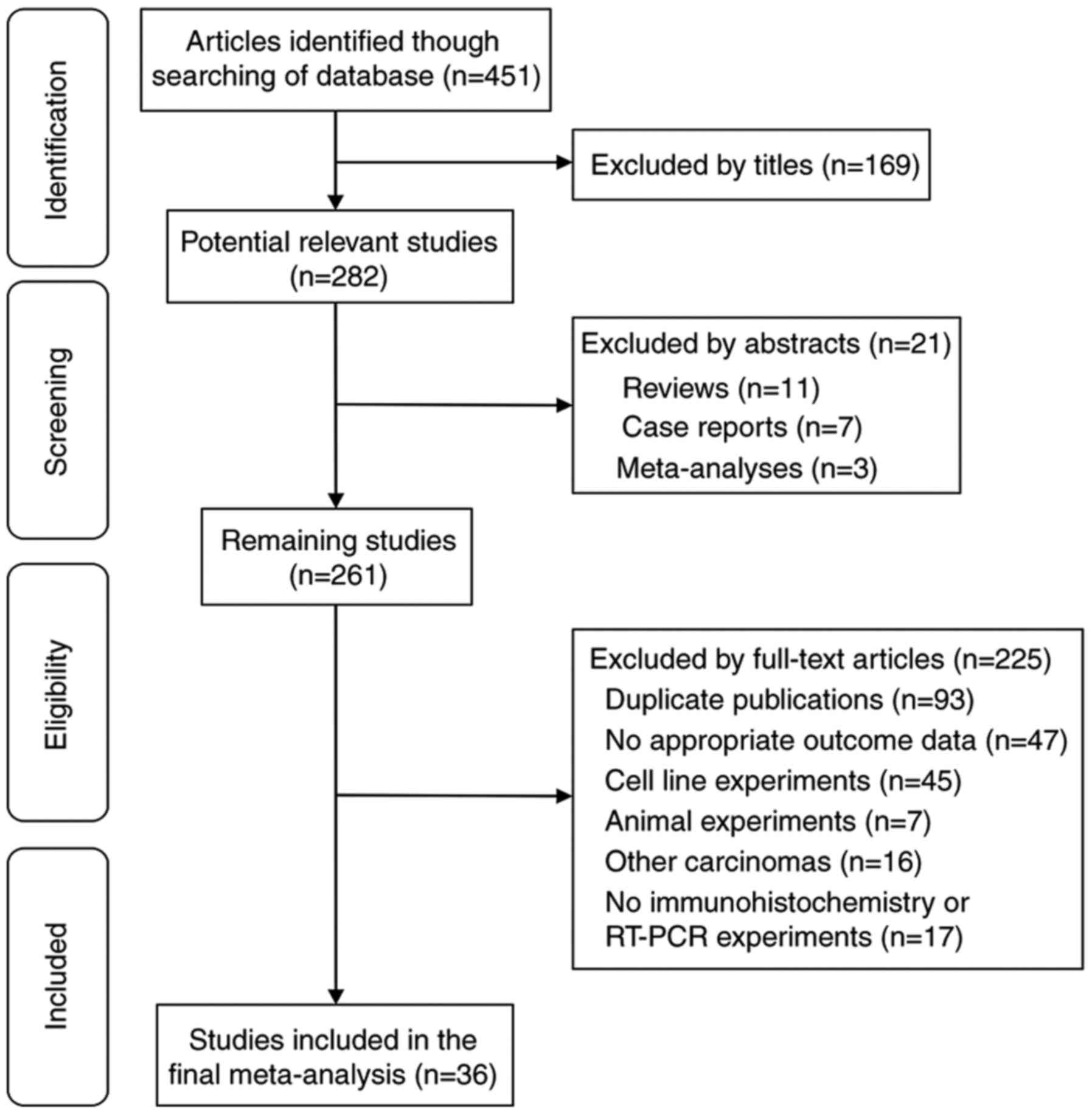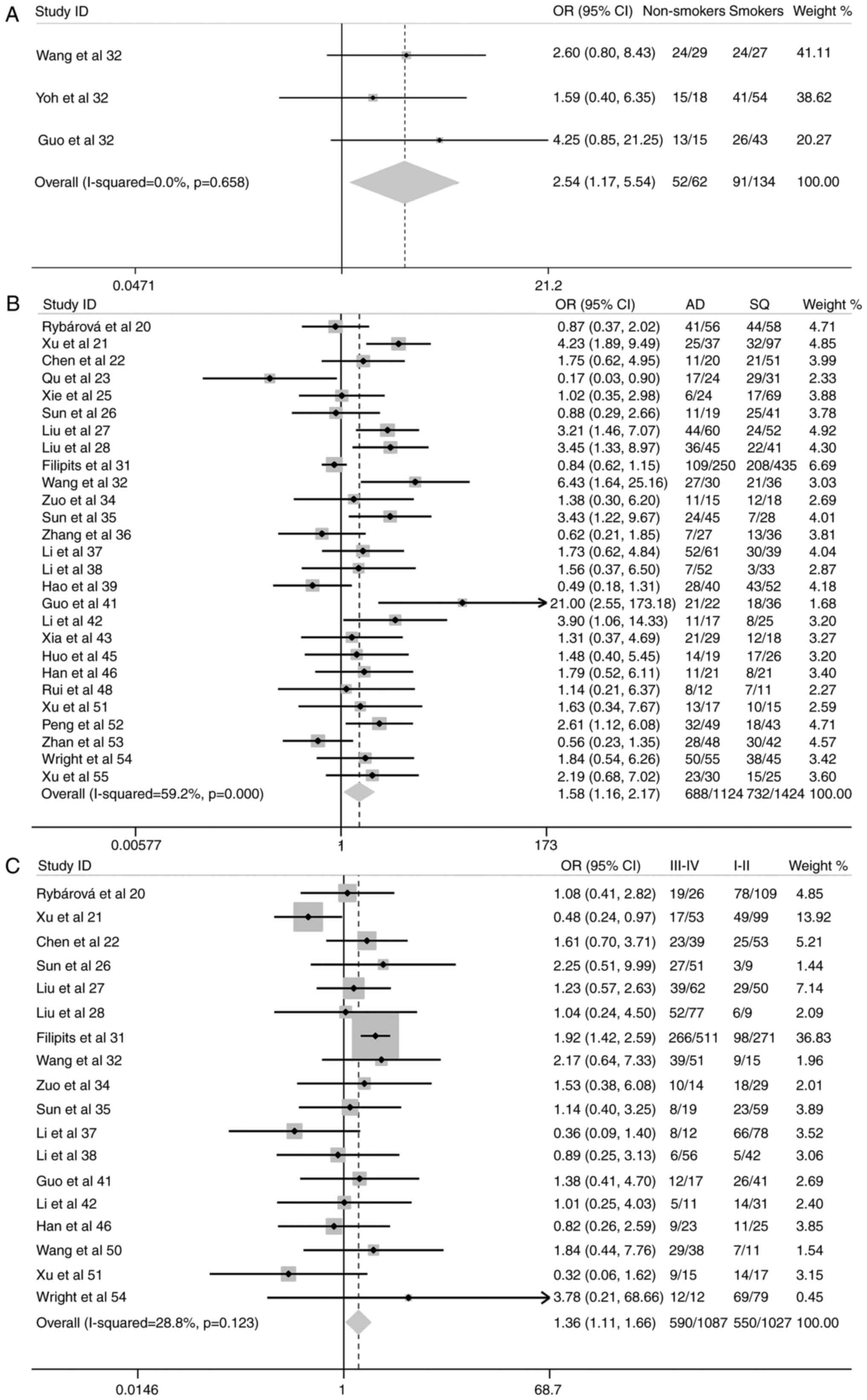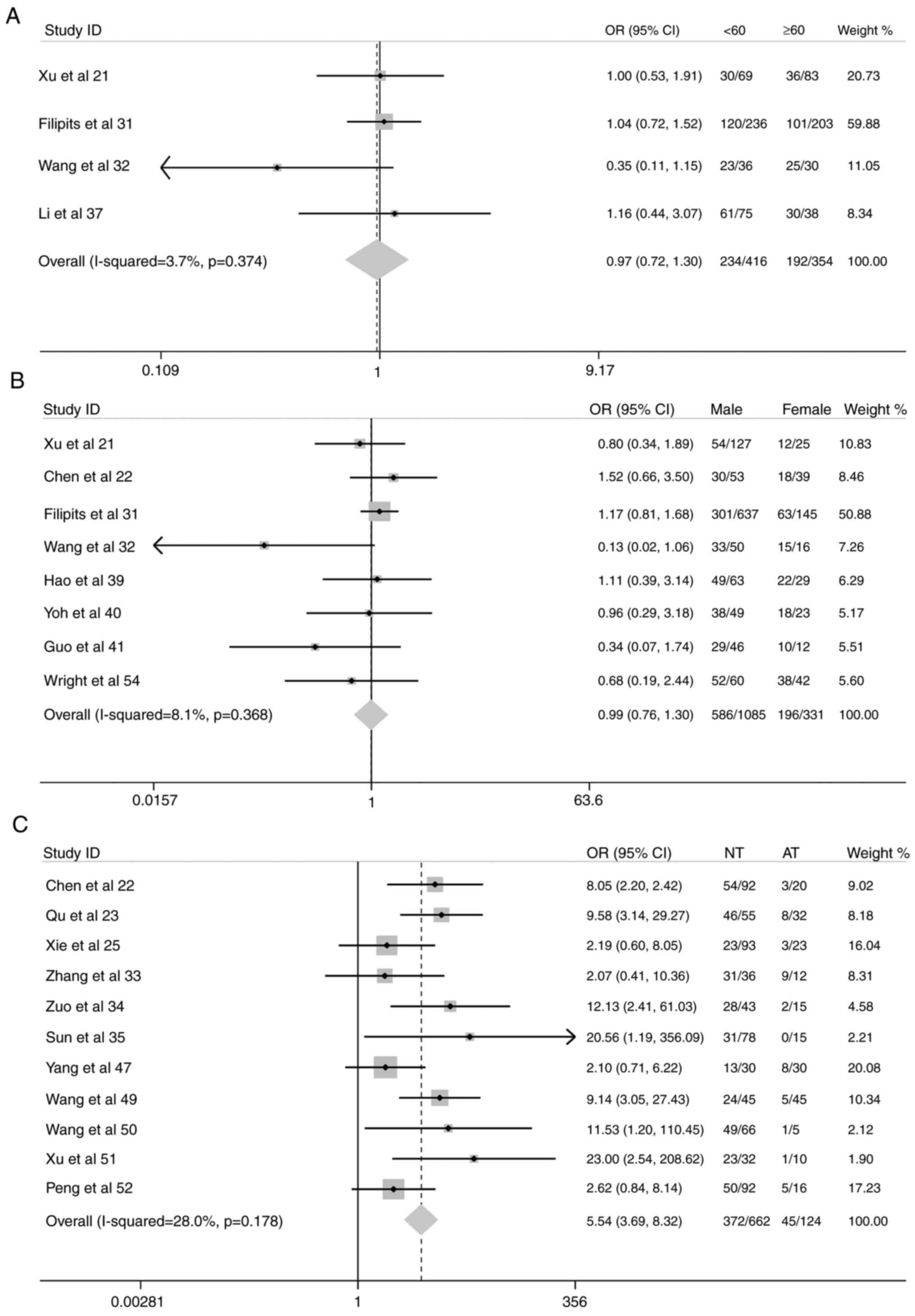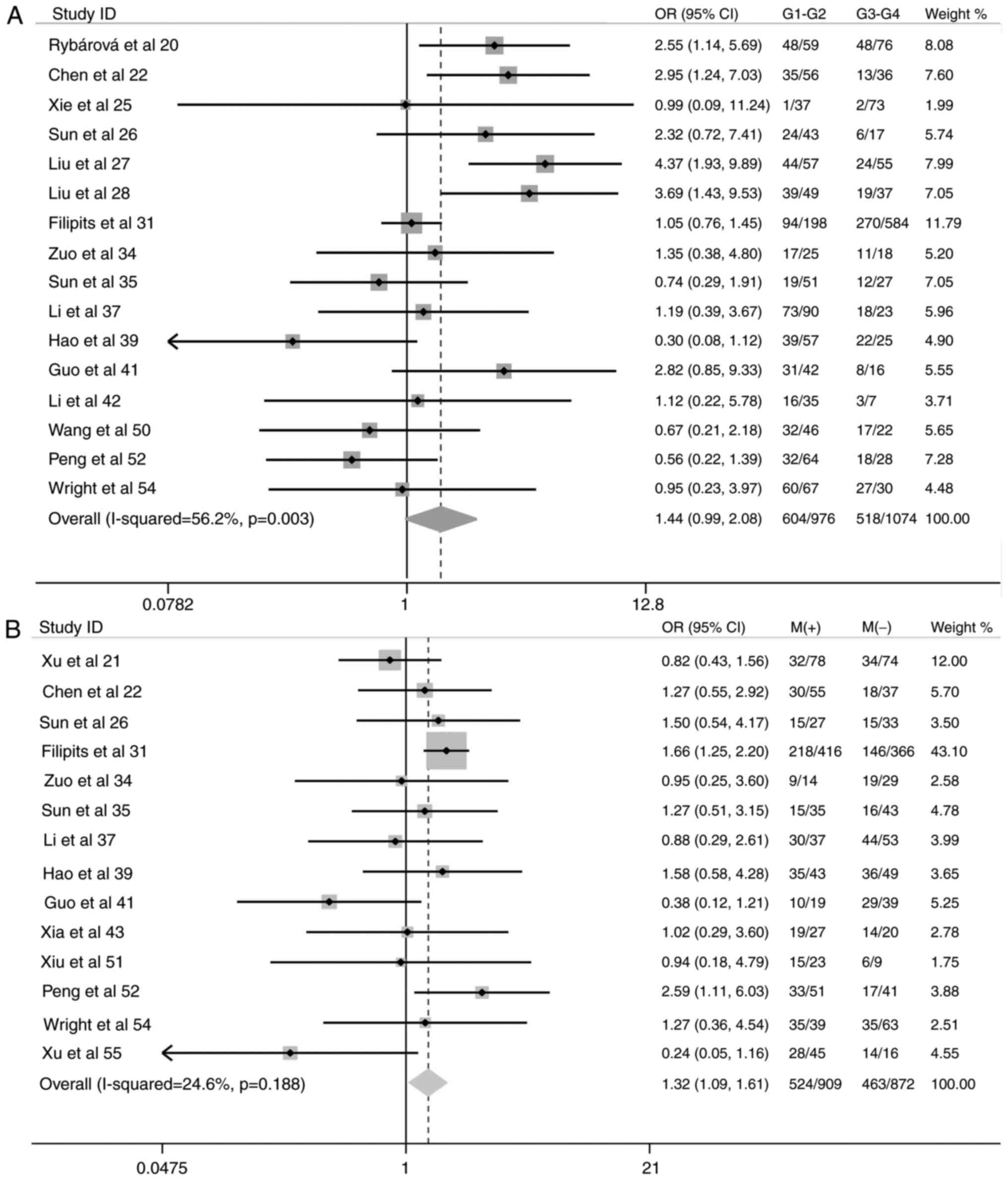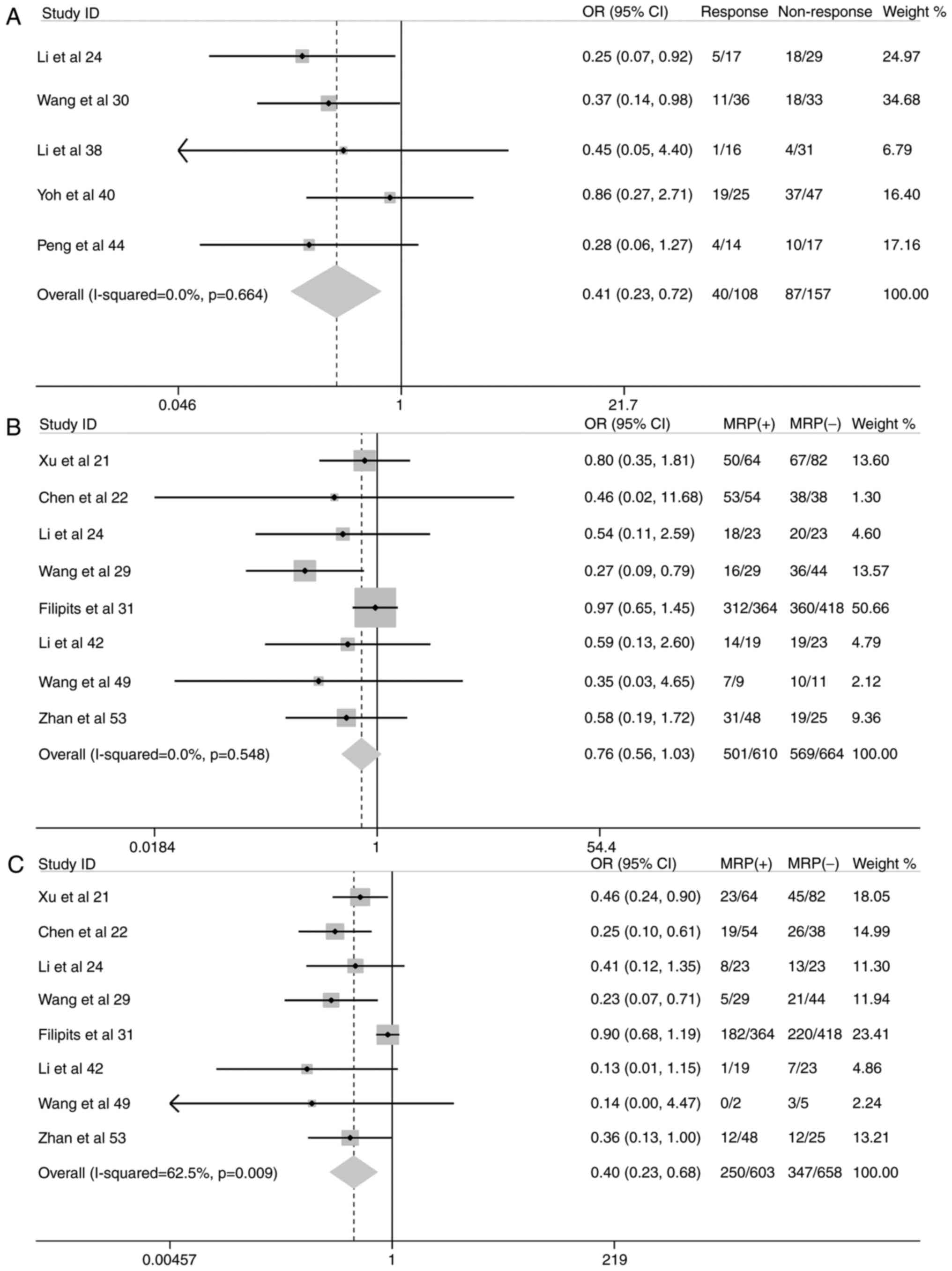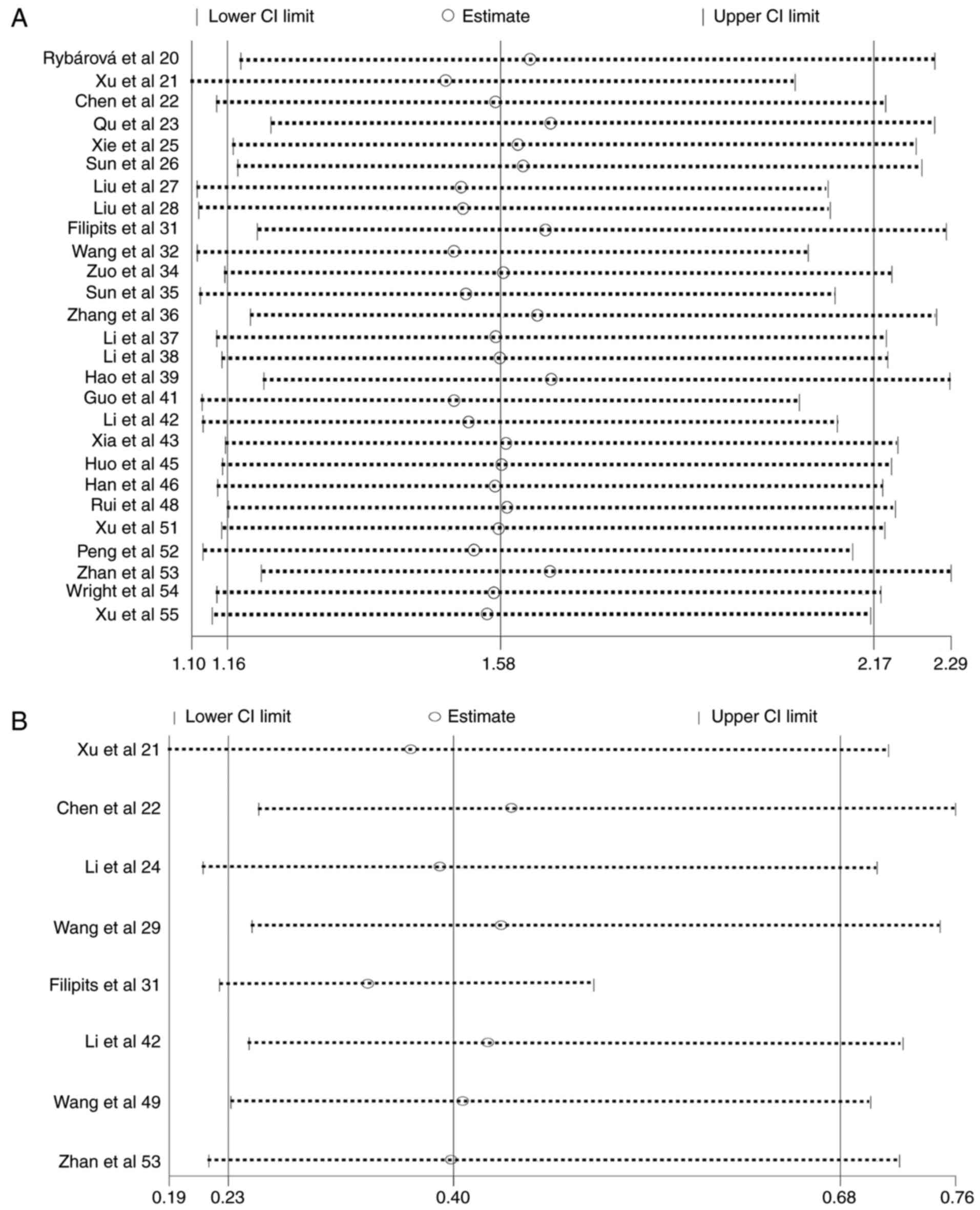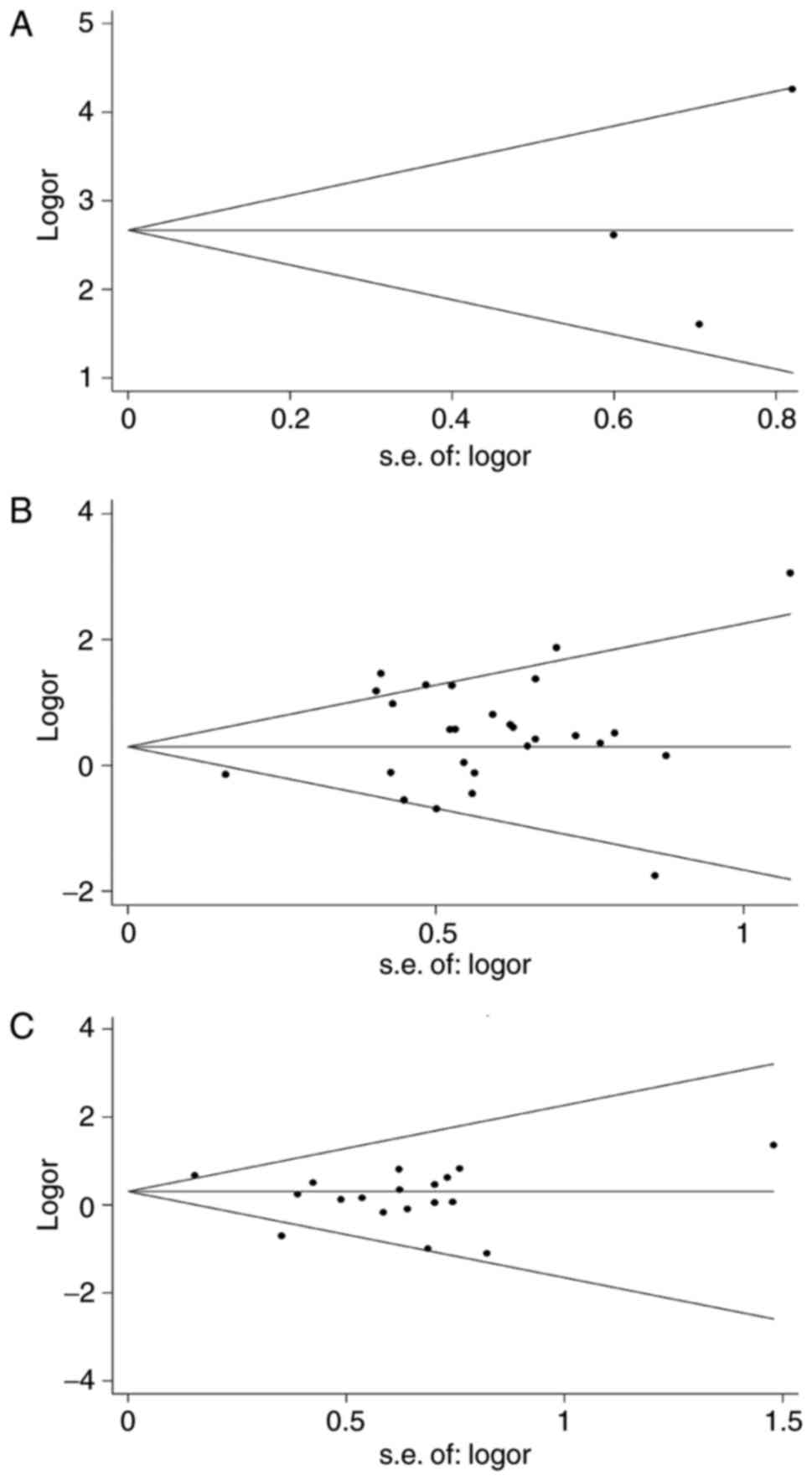|
1
|
Siegel RL, Miller KD and Jemal A: Cancer
statistics, 2016. CA Cancer J Clin. 66:7–30. 2016. View Article : Google Scholar : PubMed/NCBI
|
|
2
|
Molina JR, Yang P, Cassivi SD, Schild SE
and Adjei AA: Non-small cell lung cancer: Epidemiology, risk
factors, treatment, and survivorship. Mayo Clin Proc. 83:584–594.
2008. View Article : Google Scholar : PubMed/NCBI
|
|
3
|
Meza R, Meernik C, Jeon J and Cote ML:
Lung cancer incidence trends by gender, race and histology in the
United States, 1973–2010. PLoS One. 10:e01213232015. View Article : Google Scholar : PubMed/NCBI
|
|
4
|
Chen W, Zheng R, Baade PD, Zhang S, Zeng
H, Bray F, Jemal A, Yu XQ and He J: Cancer statistics in China,
2015. CA Cancer J Clin. 66:115–132. 2016. View Article : Google Scholar : PubMed/NCBI
|
|
5
|
Guan WJ, Zheng XY, Chung KF and Zhong NS:
Impact of air pollution on the burden of chronic respiratory
diseases in China: Time for urgent action. Lancet. 388:1939–1951.
2016. View Article : Google Scholar : PubMed/NCBI
|
|
6
|
Zhou C: Lung cancer molecular epidemiology
in China: Recent trends. Transl Lung Cancer Res. 3:270–279.
2014.PubMed/NCBI
|
|
7
|
Stewart B and Wild CP: World cancer report
2014. Health (NY); 2017
|
|
8
|
Cole SP, Bhardwaj G, Gerlach JH, Mackie
JE, Grant CE, Almquist KC, Stewart AJ, Kurz EU, Duncan AM and
Deeley RG: Overexpression of a transporter gene in a
multidrug-resistant human lung cancer cell line. Science.
258:1650–1654. 1992. View Article : Google Scholar : PubMed/NCBI
|
|
9
|
Zhang H, Patel A, Ma SL, Li XJ, Zhang YK,
Yang PQ, Kathawala RJ, Wang YJ, Anreddy N, Fu LW and Chen ZS: In
vitro, in vivo and ex vivo characterization of ibrutinib: A potent
inhibitor of the efflux function of the transporter MRP1. Br J
Pharmacol. 171:5845–5857. 2014. View Article : Google Scholar : PubMed/NCBI
|
|
10
|
Flens MJ, Zaman GJ, van der Valk P,
Izquierdo MA, Schroeijers AB, Scheffer GL, van der Groep P, de Haas
M, Meijer CJ and Scheper RJ: Tissue distribution of the multidrug
resistance protein. Am J Pathol. 148:1237–1247. 1996.PubMed/NCBI
|
|
11
|
Lok HC, Rahmanto Suryo Y, Hawkins CL,
Kalinowski DS, Morrow CS, Townsend AJ, Ponka P and Richardson DR:
Nitric oxide storage and transport in cells are mediated by
glutathione S-transferase P1-1 and multidrug resistance protein 1
via dinitrosyl iron complexes. J Biol Chem. 287:607–618. 2012.
View Article : Google Scholar : PubMed/NCBI
|
|
12
|
Cole SP: Targeting multidrug resistance
protein 1 (MRP1, ABCC1): Past, present, and future. Annu Rev
Pharmacol Toxicol. 54:95–117. 2014. View Article : Google Scholar : PubMed/NCBI
|
|
13
|
Keppler D: Multidrug resistance proteins
(MRPs, ABCCs): Importance for pathophysiology and drug therapy.
Handb Exp Pharmacol. 299–323. 2011. View Article : Google Scholar : PubMed/NCBI
|
|
14
|
Li XQ, Li J, Shi SB, Chen P, Yu LC and Bao
QL: Expression of MRP1, BCRP, LRP and ERCC1 as prognostic factors
in non-small cell lung cancer patients receiving postoperative
cisplatin-based chemotherapy. Int J Biol Markers. 24:230–237. 2009.
View Article : Google Scholar : PubMed/NCBI
|
|
15
|
Lu JF, Pokharel D and Bebawy M: MRP1 and
its role in anticancer drug resistance. Drug Metab Rev. 47:406–419.
2015. View Article : Google Scholar : PubMed/NCBI
|
|
16
|
Munoz M, Henderson M, Haber M and Norris
M: Role of the MRP1/ABCC1 multidrug transporter protein in cancer.
IUBMB Life. 59:752–757. 2007. View Article : Google Scholar : PubMed/NCBI
|
|
17
|
Moher D, Liberati A, Tetzlaff J and Altman
DG: PRISMA Group: Preferred reporting items for systematic reviews
and meta-analyses: The PRISMA statement. Int J Surg. 8:336–341.
2010. View Article : Google Scholar : PubMed/NCBI
|
|
18
|
Myung SK, Ju W, McDonnell DD, Lee YJ,
Kazinets G, Cheng CT and Moskowitz JM: Mobile phone use and risk of
tumors: A meta-analysis. J Clin Oncol. 27:5565–5572. 2009.
View Article : Google Scholar : PubMed/NCBI
|
|
19
|
Sutton AJ, Song F, Gilbody SM and Abrams
KR: Modelling publication bias in meta-analysis: A review. Stat
Methods Med Res. 9:421–445. 2000. View Article : Google Scholar : PubMed/NCBI
|
|
20
|
Rybárová S, Hodorová I, Mihalik J and
Mirossay L: MRP1 and GSTp1 expression in non-small cell lung cancer
does not correlate with clinicopathological parameters: A Slovakian
population study. Acta Histochem. 116:1390–1398. 2014. View Article : Google Scholar : PubMed/NCBI
|
|
21
|
Xu Y, Wang L, Zheng X, Liu G, Wang Y, Lai
X and Li J: Positive expression of p53, c-erbB2 and MRP proteins is
correlated with survival rates of NSCLC patients. Mol Clin Oncol.
1:487–492. 2013. View Article : Google Scholar : PubMed/NCBI
|
|
22
|
Chen ZJ, Le HB, Zhang YK, Qian LY, Sekhar
KR and Li WD: Lung resistance protein and multidrug resistance
protein in non-small cell lung cancer and their clinical
significance. J Int Med Res. 39:1693–1700. 2011. View Article : Google Scholar : PubMed/NCBI
|
|
23
|
Qu Z, Jiang J, Qu J, Tian R and Zhao N: A
study on the expression and biological significance of PTEN and MRP
in NSCLC tissues. Chin J Geriatrics. 31:22011.
|
|
24
|
Li J, Li ZN, Yu LC, Bao QL, Wu JR, Shi SB
and Li XQ: Association of expression of MRP1, BCRP, LRP and ERCC1
with outcome of patients with locally advanced non-small cell lung
cancer who received neoadjuvant chemotherapy. Lung Cancer.
69:116–122. 2010. View Article : Google Scholar : PubMed/NCBI
|
|
25
|
Xie H, Yu X, Ke M and Jiang Y: A study on
the expression of multidrug resistance-associated protein genes in
lung cancer tissues and other malignant tumor. Pract J Cancer.
25:150–153. 2010.
|
|
26
|
Sun C, Shi H and Yuan D: Study on the
correlation between expression of p53/MDR and drug resistance in
non-small cell lung cancer. Hainan Med J. 21:45–48. 2010.
|
|
27
|
Liu X, Zhang S, Xu S, Wei H and Liu Y:
Expression and clinical significance of LRP and MRP in non-small
cell lung cancer tissues by bronchoscopy biopsy. Chin J Lung
Cancer. 12:571–573. 2009.
|
|
28
|
Liu Y, Zhang S, Xing Q, Yang Y, Wei H and
Xu S: Expression and clinical significance of P-gp, LRP, MRP and
GST-π in non-small cell lung cancer tissues. J Modern Oncol.
17:1444–1447. 2009.
|
|
29
|
Wang X, Jiang H, Zhong H and Yu X:
Relationship between prognosis and expression of MRP and pS3 in
non-small cell lung cancer alter neoadjuvant chemotherapy. J Clin
Pulm Med. 13:150–153. 2008.
|
|
30
|
Wang X, Jiang H, Zhong H and Yu X:
Pathological characteristics and expression of MRP and p53 in
non-small cell lung cancer after neoadjuvant chemotherapy. Clin Med
(Northfield Il). 28:109–111. 2008.
|
|
31
|
Filipits M, Haddad V, Schmid K, Huynh A,
Dunant A, André F, Brambilla E, Stahel R, Pignon JP, Soria JC, et
al: Multidrug resistance proteins do not predict benefit of
adjuvant chemotherapy in patients with completely resected
non-small cell lung cancer: International Adjuvant Lung Cancer
Trial Biologic Program. Clin Cancer Res. 13:3892–3898. 2007.
View Article : Google Scholar : PubMed/NCBI
|
|
32
|
Wang H, Wang Q, Fan Q, et al: Expression
of multidrug resistance proteins P-glycoprotein, multidrug
resistance associated protein 1 and breast cancer resistance
protein in non-small cell lung cancer:correlation with pro gnosis.
Central Plains Med J. 34:1–5. 2007.
|
|
33
|
Zhang Y, Wang C, Sun J and Song G:
Expressions and significance of MRP1 mRNA and GST-π mRNA in NSCLC
tissues. Chin J Cancer Prev Treat. 14:913–917. 2007.
|
|
34
|
Zuo Y, Huang J, Mu C and Shen D: The
expression and significance of the multidrug resistance-associated
genes MDR1, MRP1, LRP mRNA and their proteins P-gp, MRP, LRP in
human non-small cell lung cancer tissues. Chin Clin Oncol.
11:921–929. 2006.
|
|
35
|
Sun Z, Yu H, Liu H, Li Y, He J and Sun J:
Expression of P-glycoprotein, multidrug resistance-associated
protein, lung resistance-related protein, P53 and cerbB-2 in
non-small cell lung cancer. Acad J Sec Mil Med Univ. 27:474–478.
2006.
|
|
36
|
Zhang L, Yang H and Dong D: Study on the
relationship among multidrug resistance factor expression of lung
cancer tissues and clinicopathological characteristics in patients
with lung cancer. Chin J Lung Cancer. 9:60–64. 2006.
|
|
37
|
Li L, Xiong YY, Liu L, Chen TX, Yao XF and
Wang YW: Relarionships among expressions of hTERT, MDR1, MRPmRNA,
and C-myc protein in non-small cell lung cancer. Ai Zheng.
24:53–57. 2005.(In Chinese). PubMed/NCBI
|
|
38
|
Li C, Hou M, Zhao Y and Zhou Q: Expression
of multidrug resistance-associated proteins in non-small cell lung
cancer tissues and its clinical significance. Chin J Lung Cancer.
8:523–527. 2005.
|
|
39
|
Hao J, Wang H, Wang E, Qiu X, Li Q and Liu
Y: Expression of multi-drug resistance-associated protein (MRP) and
its relationship with clinicopathological factors in non-small cell
lung cancer. Chin J Cancer Res. 16:34–39. 2004. View Article : Google Scholar
|
|
40
|
Yoh K, Ishii G, Yokose T, Minegishi Y,
Tsuta K, Goto K, Nishiwaki Y, Kodama T, Suga M and Ochiai A: Breast
cancer resistance protein impacts clinical outcome in
platinum-based chemotherapy for advanced non-small cell lung
cancer. Clin Cancer Res. 10:1691–1697. 2004. View Article : Google Scholar : PubMed/NCBI
|
|
41
|
Guo Y and Wang Y, Wang X, Yang H and Wang
Y: Expression and clinical significance of resistance-related genes
in non-small cell lung cancer tissue. Chin J Clin Oncol.
31:391–396. 2004.
|
|
42
|
Li Q, Lu X, Hu J, Jin XL and Zhao X:
Expression and clinical significance of multi-drug resistance
associated protein and P-glycoprotein in non-small cell lung
cancer. Clinical Focus. 19:906–909. 2004.
|
|
43
|
Xia S, Yu S, Yuan X and Fu X: The relative
study on the expression of HIF-1a, P-gp, and MRP in non-small cell
lung cancer. Chin J Exp Surg. 21:1515–1518. 2004.
|
|
44
|
Peng ZM, Luo J, Wang WB, Wang XH, Chen JH
and Lan SM: Predictive value of drug resistance-related genes
expression in neoadjuvant chemotherapy in patients with non-small
cell lung cancer of stage III. Ai Zheng. 23:963–967. 2004.(In
Chinese). PubMed/NCBI
|
|
45
|
Huo J, Che C and Huang Q: Coexpression and
clinical significance of multi-drug resistance factors in lung
cancer. Zhongguo Fei Ai Za Zhi. 7:218–221. 2004.(In Chinese).
PubMed/NCBI
|
|
46
|
Han B, Liao M, Su J, Feng J, Wang E and
Dong Q: The relationship between drug sensitivity and expression of
drug resistance gene mutations in non-small cell lung cancer.
Zhonghua Jie He He Hu Xi Za Zhi. 25:727–731. 2002.(In Chinese).
PubMed/NCBI
|
|
47
|
Yang J, Dai W, Shi T and Wei X: Expression
of MDR1-mRNA, MRP-mRNA and LRP-mRNA in patients with non-small cell
lung cancer. Zhongguo Fei Ai Za Zhi. 4:175–177. 2001.(In Chinese).
PubMed/NCBI
|
|
48
|
Rui M, Li L, Liu L, Wang J and Zhang Z:
Expression of P-gp, MRP and p53 and their clinical significance in
human lung cancer tissues. Zhongguo Fei Ai Za Zhi. 4:58–62.
2001.(In Chinese). PubMed/NCBI
|
|
49
|
Wang Y, Wang A, Li X, Zhang Y and Wang W:
Expression of MDR-1 and MRP gene in non-small cell lung caner and
their relations to prognosis of the patients. Chin Clin Oncol.
6:303–308. 2001.
|
|
50
|
Wang J, Liu S and Jiang W: Expression of
LRP, MRP and MDR1 in non-small-cell lung cancer and its clinical
significance. Zhonghua Zhong Liu Za Zhi. 22:304–307. 2000.(In
Chinese). PubMed/NCBI
|
|
51
|
Xu M, Li J and Xia Q: Expression of
multidrug resistance-associated protein gene in non-small cell lung
cancer. Zhonghua Jie He He Hu Xi Za Zhi. 22:268–270. 1999.(In
Chinese). PubMed/NCBI
|
|
52
|
Peng X, Feng F, Zhang W, Wu B, Chang S and
Jin S: Expression of multidrug resistance-associated protein in
human non-small cell lung cancer. Chin J Tuberc Respir Dis.
22:655–659. 1999.
|
|
53
|
Zhan M, X L, Li J and Jiang W: Clinical
significance of detecting MRP in 110 patients with lung cancer.
Chin J Clin Oncol. 26:732–735. 1999.
|
|
54
|
Wright SR, Boag AH, Valdimarsson G,
Hipfner DR, Campling BG, Cole SP and Deeley RG: Immunohistochemical
detection of multidrug resistance protein in human lung cancer and
normal lung. Clin Cancer Res. 4:2279–2289. 1998.PubMed/NCBI
|
|
55
|
Xu M, Li J and Xie J: Expression and
clinical importance of multidrug resistance-associated protein gene
in non-small cell lung cancer. China J Mod Med. 8:4–8. 1998.
|
|
56
|
van der Deen M, de Vries EG, Visserman H,
Zandbergen W, Postma DS, Timens W and Timmer-Bosscha H: Cigarette
smoke extract affects functional activity of MRP1 in bronchial
epithelial cells. J Biochem Mol Toxicol. 21:243–251. 2007.
View Article : Google Scholar : PubMed/NCBI
|
|
57
|
Leslie EM, Ito K, Upadhyaya P, Hecht SS,
Deeley RG and Cole SP: Transport of the beta -O-glucuronide
conjugate of the tobacco-specific carcinogen
4-(methylnitrosamino)-1-(3-pyridyl)-1-butanol (NNAL) by the
multidrug resistance protein 1 (MRP1). Requirement for glutathione
or a non-sulfur-containing analog. J Biol Chem. 276:27846–27854.
2001. View Article : Google Scholar : PubMed/NCBI
|
|
58
|
Létourneau IJ, Bowers RJ, Deeley RG and
Cole SP: Limited modulation of the transport activity of the human
multidrug resistance proteins MRP1, MRP2 and MRP3 by nicotine
glucuronide metabolites. Toxicol Lett. 157:9–19. 2005. View Article : Google Scholar : PubMed/NCBI
|
|
59
|
van der Deen M, Marks H, Willemse BW,
Postma DS, Müller M, Smit EF, Scheffer GL, Scheper RJ, de Vries EG
and Timens W: Diminished expression of multidrug
resistance-associated protein 1 (MRP1) in bronchial epithelium of
COPD patients. Virchows Arch. 449:682–688. 2006. View Article : Google Scholar : PubMed/NCBI
|
|
60
|
Budulac SE, Postma DS, Hiemstra PS, Kunz
LI, Siedlinski M, Smit HA, Vonk JM, Rutgers B, Timens W and Boezen
HM: Groningen Leiden Universities Corticosteroids in Obstructive
Lung Disease (GLUCOLD) study group: Multidrug resistance-associated
protein-1 (MRP1) genetic variants, MRP1 protein levels and severity
of COPD. Respir Res. 11:602010. View Article : Google Scholar : PubMed/NCBI
|
|
61
|
Oshika Y, Nakamura M, Tokunaga T,
Fukushima Y, Abe Y, Ozeki Y, Yamazaki H, Tamaoki N and Ueyama Y:
Multidrug resistance-associated protein and mutant p53 protein
expression in non-small cell lung cancer. Mod Pathol. 11:1059–1063.
1998.PubMed/NCBI
|
|
62
|
Zhou CZ, Li Y and Xu J: Correlation
between p53 gene mutation and the expression of tumor drug
resistance genes in lung cancer and its clinical significance.
Zhonghua Jie He He Hu Xi Za Zhi. 27:678–682. 2004.(In Chinese).
PubMed/NCBI
|
|
63
|
Tada Y, Wada M, Migita T, Nagayama J,
Hinoshita E, Mochida Y, Maehara Y, Tsuneyoshi M, Kuwano M and Naito
S: Increased expression of multidrug resistance-associated proteins
in bladder cancer during clinical course and drug resistance to
doxorubicin. Int J Cancer. 98:630–635. 2002. View Article : Google Scholar : PubMed/NCBI
|
|
64
|
Berger W, Setinek U, Hollaus P, Zidek T,
Steiner E, Elbling L, Cantonati H, Attems J, Gsur A and Micksche M:
Multidrug resistance markers P-glycoprotein, multidrug resistance
protein 1, and lung resistance protein in non-small cell lung
cancer: Prognostic implications. J Cancer Res Clin Oncol.
131:355–363. 2005. View Article : Google Scholar : PubMed/NCBI
|
|
65
|
Liang XJ, Shen DW, Garfield S and
Gottesman MM: Mislocalization of membrane proteins associated with
multidrug resistance in cisplatin-resistant cancer cell lines.
Cancer Res. 63:5909–5916. 2003.PubMed/NCBI
|
|
66
|
Young LC, Campling BG, Cole SP, Deeley RG
and Gerlach JH: Multidrug resistance proteins MRP3, MRP1, and MRP2
in lung cancer: Correlation of protein levels with drug response
and messenger RNA levels. Clin Cancer Res. 7:1798–1804.
2001.PubMed/NCBI
|
|
67
|
Triller N, Korosec P, Kern I, Kosnik M and
Debeljak A: Multidrug resistance in small cell lung cancer:
Expression of P-glycoprotein, multidrug resistance protein 1 and
lung resistance protein in chemo-naive patients and in relapsed
disease. Lung Cancer. 54:235–240. 2006. View Article : Google Scholar : PubMed/NCBI
|
|
68
|
Yang G, Wang XJ, Huang LJ, Zhou YA, Tian
F, Zhao JB, Chen P, Liu BY, Wen MM, Li XF, et al: High ABCG4
expression is associated with poor prognosis in non-small-cell lung
cancer patients treated with cisplatin-based chemotherapy. PLoS
One. 10:e01355762015. View Article : Google Scholar : PubMed/NCBI
|
|
69
|
Han Y, Jia C, Cong X, Yu F, Cai H, Fang S,
Cai L, Yang H, Sun Y, Li D, et al: Increased expression of
TGFβR2 is associated with the clinical outcome of non-small
cell lung cancer patients treated with chemotherapy. PLoS One.
10:e01346822015. View Article : Google Scholar : PubMed/NCBI
|
|
70
|
Shao SL, Cui TT, Zhao W, Zhang WW, Xie ZL,
Wang CH, Jia HS and Liu Q: RNAi-based Knockdown of multidrug
resistance-associated protein 1 is sufficient to reverse multidrug
resistance of human lung cells. Asian Pac J Cancer Prev.
15:10597–10601. 2015. View Article : Google Scholar
|
|
71
|
Chen SF, Zhang ZY and Zhang JL: Meloxicam
increases intracellular accumulation of doxorubicin via
downregulation of multidrug resistance-associated protein 1 (MRP1)
in A549 cells. Genet Mol Res. 14:14548–14560. 2015. View Article : Google Scholar : PubMed/NCBI
|
|
72
|
Boch C, Kollmeier J, Roth A,
Stephan-Falkenau S, Misch D, Grüning W, Bauer TT and Mairinger T:
The frequency of EGFR and KRAS mutations in non-small cell lung
cancer (NSCLC): Routine screening data for central Europe from a
cohort study. BMJ Open. 3:e0025602013. View Article : Google Scholar : PubMed/NCBI
|
|
73
|
Inoue A, Suzuki T, Fukuhara T, Maemondo M,
Kimura Y, Morikawa N, Watanabe H, Saijo Y and Nukiwa T: Prospective
phase II study of gefitinib for chemotherapy-naive patients with
advanced non-small-cell lung cancer with epidermal growth factor
receptor gene mutations. J Clin Oncol. 24:3340–3346. 2006.
View Article : Google Scholar : PubMed/NCBI
|
|
74
|
Sequist LV, Martins RG, Spigel D, Grunberg
SM, Spira A, Jänne PA, Joshi VA, McCollum D, Evans TL, Muzikansky
A, et al: First-line gefitinib in patients with advanced
non-small-cell lung cancer harboring somatic EGFR mutations.
J Clin Oncol. 26:2442–2449. 2008. View Article : Google Scholar : PubMed/NCBI
|
|
75
|
Tamura K, Okamoto I, Kashii T, Negoro S,
Hirashima T, Kudoh S, Ichinose Y, Ebi N, Shibata K, Nishimura T, et
al: Multicentre prospective phase II trial of gefitinib for
advanced non-small cell lung cancer with epidermal growth factor
receptor mutations: Results of the West Japan Thoracic Oncology
Group trial (WJTOG0403). Br J Cancer. 98:907–914. 2008. View Article : Google Scholar : PubMed/NCBI
|
|
76
|
Mok TS, Wu YL, Thongprasert S, Yang CH,
Chu DT, Saijo N, Sunpaweravong P, Han B, Margono B, Ichinose Y, et
al: Gefitinib or carboplatin-paclitaxel in pulmonary
adenocarcinoma. N Engl J Med. 361:947–957. 2009. View Article : Google Scholar : PubMed/NCBI
|
|
77
|
Kim DW, Lee SH, Lee JS, Lee MA, Kang JH,
Kim SY, Shin SW, Kim HK and Heo DS: A multicenter phase II study to
evaluate the efficacy and safety of gefitinib as first-line
treatment for Korean patients with advanced pulmonary
adenocarcinoma harboring EGFR mutations. Lung Cancer. 71:65–69.
2011. View Article : Google Scholar : PubMed/NCBI
|
|
78
|
An SJ, Chen ZH, Su J, Zhang XC, Zhong WZ,
Yang JJ, Zhou Q, Yang XN, Huang L, Guan JL, et al: Identification
of enriched driver gene alterations in subgroups of non-small cell
lung cancer patients based on histology and smoking status. PLoS
One. 7:e401092012. View Article : Google Scholar : PubMed/NCBI
|
|
79
|
Pan Y, Zhang Y, Li Y, Hu H, Wang L, Li H,
Wang R, Ye T, Luo X, Zhang Y, et al: ALK, ROS1 and
RET fusions in 1139 lung adenocarcinomas: A comprehensive
study of common and fusion pattern-specific clinicopathologic,
histologic and cytologic features. Lung Cancer. 84:121–126. 2014.
View Article : Google Scholar : PubMed/NCBI
|
|
80
|
Xia N, An J, Jiang QQ, Li M, Tan J and Hu
CP: Analysis of EGFR, EML4-ALK, KRAS, and c-MET
mutations in Chinese lung adenocarcinoma patients. Exp Lung Res.
39:328–335. 2013. View Article : Google Scholar : PubMed/NCBI
|
|
81
|
Shi Y, Au JS, Thongprasert S, Srinivasan
S, Tsai CM, Khoa MT, Heeroma K, Itoh Y, Cornelio G and Yang PC: A
prospective, molecular epidemiology study of EGFR mutations in
Asian patients with advanced non-small-cell lung cancer of
adenocarcinoma histology (PIONEER). J Thorac Oncol. 9:154–162.
2014. View Article : Google Scholar : PubMed/NCBI
|
|
82
|
Wang J, Dong Y, Cai Y, Zhou L, Wu S, Liu
G, Su D, Li X, Qin N, Nong J, et al: Clinicopathologic
characteristics of ALK rearrangements in primary lung
adenocarcinoma with identified EGFR and KRAS status. J Cancer Res
Clin Oncol. 140:453–460. 2014. View Article : Google Scholar : PubMed/NCBI
|
|
83
|
Yatabe Y: EGFR mutations and the terminal
respiratory unit. Cancer Metastasis Rev. 29:23–36. 2010. View Article : Google Scholar : PubMed/NCBI
|
|
84
|
Garcia R, Franklin RA and McCubrey JA: EGF
induces cell motility and multi-drug resistance gene expression in
breast cancer cells. Cell Cycle. 5:2820–2826. 2006. View Article : Google Scholar : PubMed/NCBI
|
|
85
|
Hegedus T, Orfi L, Seprodi A, Váradi A,
Sarkadi B and Kéri G: Interaction of tyrosine kinase inhibitors
with the human multidrug transporter proteins, MDR1 and MRP1.
Biochim Biophys Acta. 1587:318–325. 2002. View Article : Google Scholar : PubMed/NCBI
|















